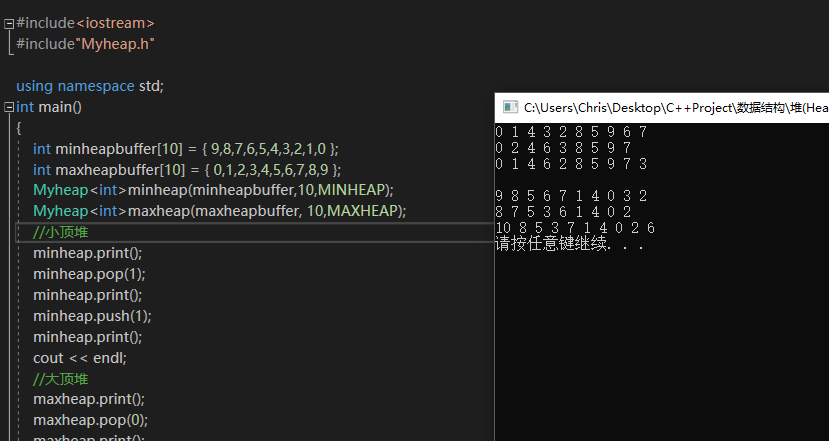C++ Heap 堆的實現(最小堆&最大堆)
阿新 • • 發佈:2018-12-05
堆 heap
堆也叫優先佇列,堆是一種特殊的完全二叉樹資料結
堆分為兩種,最大堆,最小堆。
最大堆:根節點大於左右兩個子節點的完全二叉樹
最小堆:根節點小於左右兩個子節點的完全二叉樹
堆可以用陣列來儲存,
a[i]處存根節點,a[2 * i]存左子樹的根節點 ; a[2 * i + 1]存右子樹的根節點。i從1開始!!

實現
#pragma once
#include<vector>
//using namespace std;
enum heaptype
{
MAXHEAP, MINHEAP,
};
template<class T>
class Myheap
{ 測試
//堆也叫優先佇列,堆是一種特殊的完全二叉樹資料結
//堆分為兩種,最大堆,最小堆。
//最大堆:根節點大於左右兩個子節點的完全二叉樹
//最小堆:根節點小於左右兩個子節點的完全二叉樹
//堆可以用陣列來儲存,
//a[i]處存根節點,a[2 * i]存左子樹的根節點 ; a[2 * i + 1]存右子樹的根節點。i從1開始!!
#include<iostream>
#include"Myheap.h"
using namespace std;
int main()
{
int minheapbuffer[10] = { 9,8,7,6,5,4,3,2,1,0 };
int maxheapbuffer[10] = { 0,1,2,3,4,5,6,7,8,9 };
Myheap<int>minheap(minheapbuffer,10,MINHEAP);
Myheap<int>maxheap(maxheapbuffer, 10,MAXHEAP);
//小頂堆
minheap.print();
minheap.pop(1);
minheap.print();
minheap.push(1);
minheap.print();
cout << endl;
//大頂堆
maxheap.print();
maxheap.pop(0);
maxheap.print();
maxheap.push(10);
maxheap.print();
system("pause");
return 0;
}

程式碼:
https://github.com/ChristmasError/Data_Structure/tree/master/堆 Heap
